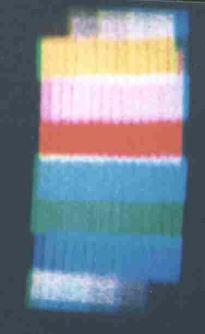INTRODUCTION
Except for some "old timers", most people believe that television came on the
market in 1947 or thereabouts. Few realize that its development began before
the civil war. The hope then was to transmit photographs over the existing
telegraph wires. Much of the early work was very limited by the hardware. As
early as 1907, a complete electronic television system, similar to the one in use
today, was described by a well-known engineer of the day, but it would be many
years before such a system could be actually built.
By the middle to late 1920's, engineers like John Logie Baird of Scotland and C.F.
Jenkins of the United States began building mechanical television equipment
utilizing the persistence of vision of the eye. They used scanning disks (or one of
its derivatives) with photo electric cells to construct the images and another disk
revolving in synchronism, to reconstitute the image. Early receivers had a neon
lamp behind the disk to provide the light to form the visible image. Their
equipment could produce recognizable moving images of persons, shapes or
forms. In 1928, Baird successfully transmitted images of London to New York, 34
years before the Telstar satellite transmitted images of London to New York,
across the Atlantic. In the same year, he also demonstrated for the first time,
television pictures in full color. By 1930, Baird was marketing the "Televisor"; the
first mass-produced television set.
Developments came rapidly during these years and by 1931-1932, many
broadcasting stations were scheduling regular television programs. By this time,
its been said that over 500,000 receivers had been manufactured or were built
by home constructors. "Lookers in" (as Mr. Jenkins liked to call them) were very
enthusiastic about their reception of his signals. Many wrote to the stations
describing their scanning equipment and told how they managed to see a
persons lips move or smoke rise from a cigarette. But mechanical television was
not destined to become a commercial success because the pictures were small
and limited to close-ups. Just as experimenters then became excited by actually
seeing pictures on these mechanisms consisting of motors and spinning disks
today you and I can enjoy the same thrills, seeing what they saw, with
equipment like they used that you can build yourself. If you're "handy" and have
tools, you can build it all. If not, purchase those parts that you don't feel
comfortable in making, but make the rest. It was common then for experimenters
to buy some manufactured components and build only a portion of their scanning
receivers. You can purchase similar materials today that are the same as those
used in my own equipment. These parts are tried, proven and they will work for
you! Those of you that have the skills and tools can and should should build their
own components, using the information available on this site or in such books as
"THE MECHANICS OF TELEVISION"
This book provides information for building various types of cameras and
receivers, which together produce operating systems that really work, with all of
the attributes of early equipment. And with a little extra effort, a cabinet can be
built along the lines of those used with original receivers. Mechanical television is
a very special unique and fascinating hobby. It can and will further the skills of
anyone that participates, young or old. The equipment never fails to attract
attention and capture the interest wherever it's shown. Many friends and acquaintances keep telling me, "Peter.... nobody wants to build
anything any more! Look at all the kit manufacturers that have gone out of
business. No doubt a lot radio collectors would like to have working mechanical
TV for display, but no one wants to take the trouble to build one."
I don't accept that.I have letters and pictures from many people who have built
or are building cameras and/or receivers based on information available in my
book. Judging from the pictures I've seen, I'd say that many of them are either
mechanics, machinists, electricians, carpenters, technicians or engineers. I
happen to know that there are also a couple of doctors out there working on
these things. Construction methods do vary quite a bit. Some use mostly wood in
their assembly and others tend to use more metal and plastics. It depends on
what you can get your hands on and what you are used to working with. Most
builders prefer to buy the electronics rather than build. But the thread that ties
all of these people together is the enthusiasm their letters exude when
describing their projects and the results they have achieved.
Going to Need parts? (Besides myself as a source)
Like most projects, the most difficult thing is getting started... This is especially
true if the project appears to be totally different from the things you've been
doing up to now. But once you get involed, you will learn as you go. Later you
will be doing things that you might not have attempted earlier. The more you
become involved, the better you understand the system and the better you're
able to make the equipment perform. This kind of project is suitable for anyone
from age 9 to 90 and if you do get stuck, I or others will help you.
The Narrow Band Television Association NBTV is dedicated to television
experimenters. They offer many parts and supplies at very low prices. They also
send out an interesting quarterly news bulletin to all paid up members, that
gives them first hand information that dovetails with ongoing NBTV activities. I've
been a member a long time , and I strongly suggest that you join up too. It costs
very little and I can't say enough nice things about this group. Contact them
through their web site. Click on the link above.
Note: The photos on this page is just a small sample of those taken with my own
mechanical television equipment, through the years.
|




|